Sanchin no Kata made it’s way into Kyokushin Karate through the founder, Sosai Masutatsu (Mas) Oyama. Sosai Oyama had a background in various arts, including 4th Dan in Shotokan, 4th Dan in Judo, Taikiken, Aikijujutsu, as well as a 7th Dan Black Belt in Goju-ryu, under Gogen Yamaguchi. Sanchin is a kata of Goju-ryu.
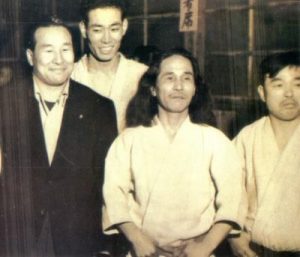
Sanchin kata is considered by many karate experts to be the oldest kata and the most important kata of Karate (along with Tensho), which is odd considering there is very little bunkai, or martial application, in the movements of Sanchin.
 Sanchin is a kata of Southern Chinese (Fujianese) origin that is considered to be the core of several styles of Okinawan Karate, like Goju Ryu and Uechi Ryu, as well as the Chinese martial arts of Fujian White Crane, Five Ancestors, Pangai-noon and the Tiger-Crane Combination style associated with Ang Lian-Huat. Tam Hon taught a style that was called simply “Saam Jin” (Cantonese for “Sanchin”). The name Sanchin, meaning three battles, is sometimes interpreted as the battle to unify the mind, body, and spirit; however, there are other interpretations of it,[1]and many esoteric notions with it.
Sanchin is a kata of Southern Chinese (Fujianese) origin that is considered to be the core of several styles of Okinawan Karate, like Goju Ryu and Uechi Ryu, as well as the Chinese martial arts of Fujian White Crane, Five Ancestors, Pangai-noon and the Tiger-Crane Combination style associated with Ang Lian-Huat. Tam Hon taught a style that was called simply “Saam Jin” (Cantonese for “Sanchin”). The name Sanchin, meaning three battles, is sometimes interpreted as the battle to unify the mind, body, and spirit; however, there are other interpretations of it,[1]and many esoteric notions with it.
The version of Sanchin used by most styles of Karate, including Kyokushin, was developed by Goju-ryu founder Chōjun Miyagi and uses a very strong, tense closed fist “push”. In Uechi-ryu and in Ryusei, the practice of Sanchin is closer to the Chinese version with faster spear hand strikes that are more snake like.[2][3][3][4][4] Kanbun Uechi, Uechi Ryu’s founder, felt that Sanchin Kata was so critical the he required his students to study it for several years before moving on to other Kata
三戦の型 Sanchin no Kata
Sanchin literally means “three battles” or “three conflicts”, from the characters San 三 (three) and Chin 戦 (war, battle or match).
Sanchin kata seeks to develop three elements at the same time:
- The mind, body and the techniques,
- The internal organs, circulation and the nervous system, and
- The three Ki 気, located in:
- the crown of the head (Nōten 脳天),
- the diaphragm (Hara 腹), and
- the lower abdomen (Tanden 丹田)
Sanchin is an isometric kata where each move is performed in a state of complete tension, accompanied by powerful, deep breathing (Ibuki 息吹) that originates in the lower abdomen (Tanden 丹田). The practice of Sanchin not only leads to the strengthening of the body, but to the development of the inner power (Ki 気) and the coordination of mind and body.
Historically amongst Okinawan Karate masters, it has been understood that you master karate only if you master Sanchin kata. There is a saying in Okinawa that “karate begins with Sanchin and ends with Sanchin, and karate fighters should practice Sanchin every day, three times.”
Sanchin expert Kris Wilder has said “Don’t look for bunkai in Sanchin, Look for Sanchin in your bunkai” and “Sanchin is like the rain. If the techniques of the other kata are the trees, Sanchin is the rain that nourishes them all.”
But, what does he mean by this and why do the old Okinawan masters put so much emphasis on the kata?
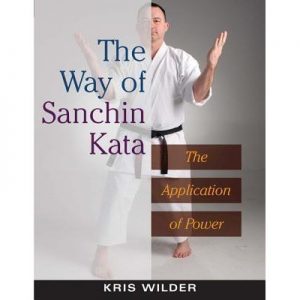 “Many practitioners believe that Sanchin Kata holds the key to mastering traditional martial arts. It is one of the simplest forms to learn, yet one of the most difficult to perfect. Those who truly understand its teachings find that it facilitates enormous quickness and power in any martial application. The challenge lies in gaining that understanding, which is something we had to uncover ourselves by trial and error until now. When Karate or Ti was first developed in Okinawa, it was about using technique and extraordinary power to end a fight instantly. These old ways of generating remarkable power are still accessible, but they are purposefully hidden in Sanchin Kata for the truly dedicated to find.” from Kris Wilder’s book The Way of Sanchin Kata: The Application of Power
“Many practitioners believe that Sanchin Kata holds the key to mastering traditional martial arts. It is one of the simplest forms to learn, yet one of the most difficult to perfect. Those who truly understand its teachings find that it facilitates enormous quickness and power in any martial application. The challenge lies in gaining that understanding, which is something we had to uncover ourselves by trial and error until now. When Karate or Ti was first developed in Okinawa, it was about using technique and extraordinary power to end a fight instantly. These old ways of generating remarkable power are still accessible, but they are purposefully hidden in Sanchin Kata for the truly dedicated to find.” from Kris Wilder’s book The Way of Sanchin Kata: The Application of Power
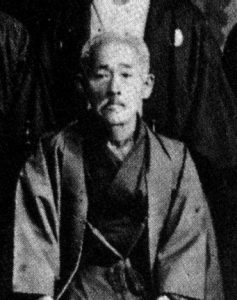
Mar 10, 1853 – Oct 1915
The true history of Sanchin kata has been lost to antiquity. According to the Goju-ryu lineage, Kanryo Higashionna (Higaonna Kanryō) (1853-1915) brought Sanchin kata back to Okinawa from Southern China. Kanbun Uechi brought another version of Sanchin kata to Okinawa, around 1918, and began teaching what would later be known as Uechi-ryu. Very similiar to the Goju-ryu version, but utilizing the Chinese open spear hand rather then the closed fist of Goju-ryu and Kyokushin that we are familiar with.
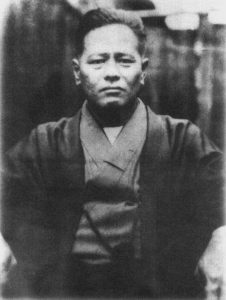
Apr 25, 1888—Oct 8, 1953
Chojun Miyagi, student of Kanryo Higashionna and the founder of Goju-ryu (meaning “hard soft style”) made changes to Sanchin kata. Miyagi took the open spear hands of the form and closed them to fists. Miyagi then took out the turns in the form his instructor Higashionna taught to create another version of the kata. Miyagi also changed the breathing taught to him making it more direct and less circulatory in nature.
A reader of the this blog, Rick Matz shared the following incredible video, which shows four great masters of the different styles performing the same kata. Morio Higaonna (Goju-ryu, 10th Dan), Shinyu Gushi (Uechi Ryu, 9th Dan), Chen Jian Feng (White Crane Boxing) and Master Pan (Yong Chun White Crane).
The Sanchin Stance
The stance is fixed and tensed. It can be described as Uchi-hachiji-dachi with one foot moved forward until the toes of the rear foot are on the same horizontal line as the heel of the front foot. The forward foot should be turned in at a 45° angle and the rear forward at 90°, with the feet at shoulder-width apart.
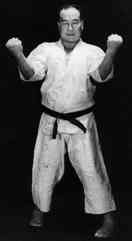
With the feet apart, it’s quite a natural stance. Despite its relatively high-posture, it’s quite a rooted, stable stance. However, its height makes it easy for you to deliver kicks. Sanchin Dachi is an ideal defensive posture for close-up fighting, and is sometimes used as a base for grappling.
A common mistake is sticking the butt out. It should be the opposite, tucking the butt under, or as Sensei Steve Fogarasi says, “your anus should point to the moon.”
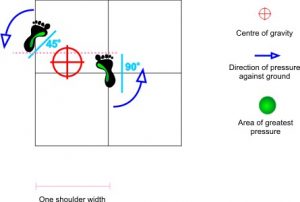
This powerful stance is used in the multitude of katas attributed to Kanryo Higashionna, from Sanchin to Suparimpei. Many advanced breathing techniques are exercised in this stance.
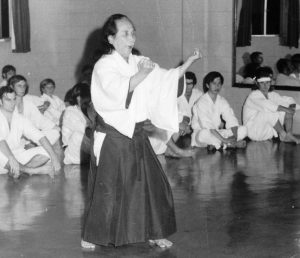
Teacher of Mas Oyama
It’s primary function is to provide rotation, which may translate to the upper body for use during blocking or striking. The front/back foot position enables you to deliver better hip rotation to your strikes than one of the parallel stances like Kiba Dachi, and this means that your strikes will have more power.
The rotation also enables you to twist from below the waist for evasion or groin protection. In fact, it is the groin protecting nature of this stance that has lead to a common misconception. People believe that to protect the groin, the knees are brought together, which in fact provides very little protection, especially against knees and thrusting kicks, but this misconception has resulted in thousands of students practicing this stance in a way that makes them look knock kneed. In actual fact, Sanchin Dachi protects the groin by enabling you to turn the genitals to the side, away from a frontal attack, placing your thighs in the way of danger
Sanchin Shime Testing
Shime translates to mean: to lock, tighten, or shut. This word is used in regard to the practitioner’s ability to lock the body down, to tighten, and to shut off the areas of vulnerability.
Shime testing is a two-person drill, conducted by a Sensei during a requirement test. The job of the second person is to assist the student being tested, to be aware and to focus and tighten on various muscle groups while moving through the kata. The testing on a student new to Sanchin kata is done by pressing and feeling rather than slapping. This assist greatly in making the student more aware and developing strong habits for beneficial Sanchin training.
The idea behind the testing is to have the practitioner, the person being tested, placed under a load, to see how their structure is working. The intent to find the weak spots in the structure, the goal being discovery, so the practitioner can correct a weakness.
What is considered to be classical testing, striking the practitioner a stick, shinai or such is actually a modern thing. This form of testing is incorrect. It should be performed with slaps and kicks.
Power begets power, the harder you hit the practitioner, the more intensely they respond, the more power they use to hold their ground. Percussive striking forces the body into a form of protection.
Sanchin in Kyokushin
Sanchin kata made its way into the curriculum of Kyokushin Karate because of Sosai Oyama’s extensive background in Goju-ryu, under fellow Korean Nei-Chu So, a student under the mysteries and famous Goju-ryu teacher, Gogen Yamaguchi. Mas Oyama trained from time to time with Gogen Yamaguchi, even joining the latter’s Goju-kai and obtaining the rank of 7th Dan Black Belt.
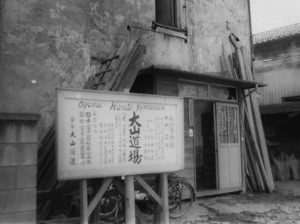
Furthermore, it is easy to see why Sosai Oyama would want the kata as part of his new system. Sosai Oyama considered the three most important principles of kata training to be the tempo of technique, the points of power stress, and breath control. So we can see why he would have incorporated Sanchin, which focuses on these “three battles”.
Sosai Oyama deemed the three essential principles of kata training to be:
Waza no Kankyu – Tempo of Technique
The tempo of techniques varies throughout kata. The practice of varied tempo is meant to upset the timing of an opponent’s counter attack. It is also the method in which one practices reacting to an attack, employing the appropriate response by maintaining control of one’s own tempo and not reacting unnecessarily.
Chikara no Kyojaku – Points of Power Stress
The points of power also vary in kata. The power of certain moves in kata are stressed more than others. All kiai moves in kata call for maximum power generation. Other moves depend on fluidity and speed to create the power.
Iki no Chosei – Breath Control
Correct breathing is of extreme importance in kata and must be coordinated with the execution of technique. Proper breath control helps to still the mind and unite body, mind and spirit. The inhalation phase is coordinated with the relaxed state of the body (such as chambered position) just prior to execution of the technique. Upon execution of the technique, the exhalation is completed. Breath control also keeps the body oxygenated and improves stamina.
Sanchin no Kata teaches all the three aspects of Sosai Oyama’s principles of kata training, as well, through it’s shime testing, it would demonstrate The Ultimate Truth.
Osu!
Sanchin as performed by Sensei George Evangelidakis, Shin-Kyokushin
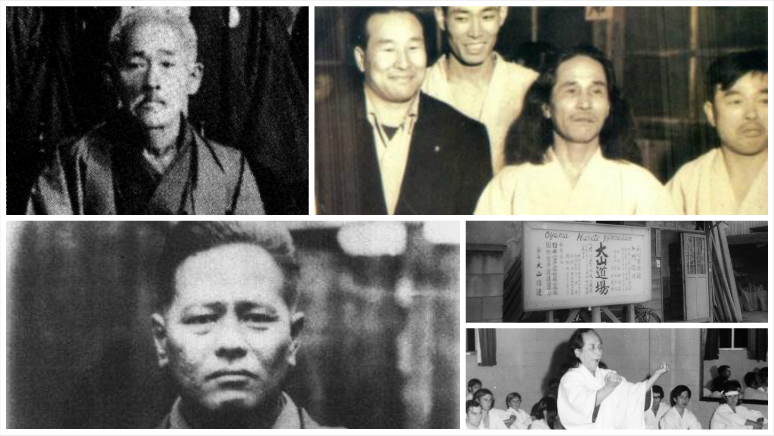
hai sensei tenho uma dovida despues dos 3 pasos para dar a vuelta para otro lado donde esto dando vulta eso e certo o porque Nao sei más ums dicen que de vemos olhar para otro lado so par alado que vo dar vulta
Really good article dwde . I have been getting really interested in this kata lately .
[…] the body, which can also do great things (along with the mind and breath—the three human elements as karate and other martial arts teaches). How we hold our bodies (often shoulders hunched in front of a computer or slouched on a couch) […]
Karate is my life.
Hi Scott,
Thank’s for your explanation.
Yes, I’ve seen this image of Sosai , too.
But I’m still confused, because in “What is Karate?” page 76 of Sosai himself both feeth are at a 45°
angle. And my shihan told us the same…
Please notice that the sanchin dachi diagram shown in this article is wrong… because both feet have to have the heels pointed outside… (both feet should be turned in at a 45° angle)
This sentence in the article is therefore not correct:
….. The forward foot should be turned in at a 45° angle and the rear forward at 90°,……
See “What is Karate?” page 76.
Excellent text, congratulations for the initiative.
Excellent. I hope you don’t mind if I “share” it on the FB page of International Uechi Ryu Karate Federation. Thank you.
Thanks for posting. A very interesting article. Since you mention my grand master Ang Lian Huat, did you know that Mas Oyama, on his famous visit to Singapore to observe Chinese Kung Fu Masters visited Nam Yang Pugilistic Association where he watched Grand Master Ang Lian Huat demonstrate his Sum Chien (Sanchin) and I believe demonstrated his own Sanchin? I believe that this took place in the 1970’s showing that the Japanese were taking an interest in their roots in Chinese kung fu even back then. Again, thanks for posting Scott. Iain.
osu
Sanchin, performed by karate masters of different styles, plus a white crane kung fu master:
http://cookdingskitchen.blogspot.com/2010/04/sanchin-kata-comparision.html